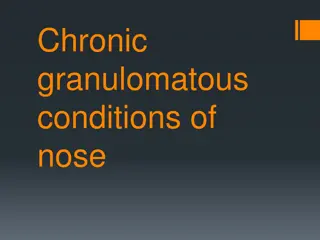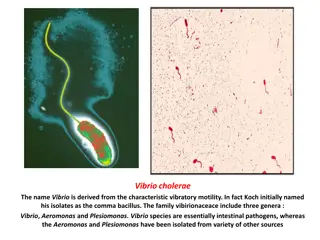Understanding Clostridium Tetani: Characteristics and Habitats
Clostridium tetani is an obligate anaerobe that forms terminal spores giving it a drumstick-like appearance. It is heat-sensitive, non-motile, and can produce toxins. Spores are found in soil and the gastrointestinal tracts of various animals. The bacterium can also be present on human skin and in c
0 views • 23 slides
Understanding Vibrio Cholerae: Biology and Impact on Human Health
Vibrio cholerae is a significant bacterium responsible for causing cholera, a life-threatening diarrheal disease. With over 35 species in the Vibrio genus, only a few can infect humans. Vibrio cholerae is a Gram-negative, curved aerobic rod that produces an enterotoxin leading to cholera. Understand
0 views • 23 slides
Understanding Rhinoscleroma: A Chronic Granulomatous Condition of the Nose
Rhinoscleroma is a chronic granulomatous condition of the nose caused by infection with the bacterium rhinoscleromatis. It primarily affects the nasal cavity but can also involve other respiratory tract structures. The disease is contracted through inhalation and exhibits distinct pathological stage
0 views • 31 slides
Overview of Vibrio cholerae: Characteristics and Identification
Vibrio cholerae is a gram-negative, curved rod bacterium known for causing cholera. Its distinctive features include polar flagellum motility, oxidase-positive nature, and resistance to inhibitory substances. Various culture media are used for its isolation and growth, such as transport, routine, an
0 views • 8 slides
Salmonellosis: Causes, Clinical Presentations, and Transmission
Salmonellosis is caused by the gram-negative bacterium Salmonella enterica. It predominantly affects warm-blooded vertebrates, leading to carrier states, septicemia, enteritis, and other clinical presentations like abortion and arthritis. The disease is transmitted through contaminated foods of anim
0 views • 15 slides
Overview of Pseudomonas aeruginosa: Morphology, Identification, and Lab Diagnosis
Pseudomonas aeruginosa is a gram-negative, motile bacterium commonly found in soil, water, plants, and animals. It is a major pathogen known for causing infections in individuals with weakened immune systems. This article delves into the morphology, identification techniques, and lab diagnosis metho
0 views • 7 slides
Understanding Transgenic Plants and Agrobacterium Tumefaciens in Plant Biotechnology
Creation of transgenic plants involves various methods such as microprojectile DNA-coating, electroporation, and Agrobacterium transformation. Agrobacterium tumefaciens, a soil bacterium, plays a crucial role in inducing crown gall disease in plants by transferring T-DNA from the Ti plasmid. The Ti
1 views • 27 slides
Buy Botox 200U Online - dermafillerstore.com
Buy Botox 200U Online is a brand name for a toxin produced by the bacterium Clostridium botulinum. Although it's best known for its cosmetic use in reducing the appearance of wrinkles, Botox is also used for various medical conditions, such as chroni
1 views • 4 slides
Overview of Vinavirales and Related Viral Groups
Vinavirales is a group of viruses that were previously part of the PM2-like group. The content discusses various species and bacterium within Vinavirales, as well as related groups such as Nucleocytoviricota and Virophages. It explores their presence in marine metagenomes, sediment environments, and
0 views • 7 slides
Helicobacter Pylori: Characteristics, Pathogenesis, and Diagnosis
Helicobacter pylori is a spiral-shaped Gram-negative bacterium associated with various gastrointestinal conditions like gastritis, duodenal ulcers, gastric ulcers, and gastric carcinoma. It exhibits unique characteristics in common with Campylobacters and has specific culture and growth requirements
0 views • 5 slides
Understanding Listeria Monocytogenes Infections
Listeria monocytogenes is a bacterium that infects humans, especially pregnant women, newborns, and immunocompromised individuals. It can be differentiated from other bacteria based on its morphology, culture characteristics, and biochemical tests. This summary covers important aspects such as its g
0 views • 14 slides
Understanding Yersinia Pestis: The Bacterium Behind the Black Death
Yersinia pestis, the causative agent of the infamous Black Death, is a Gram-negative coccobacilli bacterium. It is transmitted through fleas and affects lymph nodes, causing bubonic plague. This article explores its general characteristics, pathogenesis, virulence factors, laboratory diagnosis, and
0 views • 18 slides
The Devastating Impact of the Bubonic Plague in Medieval Times
The Bubonic Plague, caused by the bacterium Yersinia pestis, ravaged Western Europe during the late Middle Ages, resulting in over 75 million deaths. Spread through rats carrying infested fleas, the disease caused agonizing swellings and ultimately death, with no known cure in the 1300s. The unsanit
0 views • 11 slides
Comprehensive Guide to Lyme Disease: Prevention, Transmission, Symptoms, and Treatment
Lyme disease, caused by the Borrelia burgdorferi bacterium transmitted through tick bites, can lead to various symptoms if left untreated. Learn about prevention methods, how to handle tick bites, recognize symptoms, and understand the challenges in testing and treating acute and chronic Lyme diseas
0 views • 14 slides
Understanding Pseudomonas aeruginosa: Characteristics, Culture, and Pathogenicity
The genus Pseudomonas, specifically P. aeruginosa, is a well-known opportunistic pathogen found in diverse ecological niches. This bacterium, commonly associated with disease conditions in animals and humans, exhibits unique growth characteristics, pigment production, and virulence factors. Its adap
1 views • 14 slides
Understanding Tetanus: Causes, Symptoms, and Treatment
Tetanus, also known as lockjaw, is a bacterial infection characterized by muscle spasms that can lead to severe complications. It is caused by the bacterium Clostridium tetani, commonly found in soil, saliva, and manure. Symptoms include muscle spasms, lockjaw, and difficulty swallowing. Tetanus can
0 views • 10 slides
Understanding Cholera - Causes, Symptoms, and Prevention Strategies
Cholera is an acute intestinal infection caused by the bacterium Vibrio cholerae. It leads to watery diarrhea due to the production of a potent enterotoxin. The disease has two distinct life cycles - one in the environment and one in humans. Factors such as access to safe water and sanitation play a
0 views • 21 slides
Understanding Bacterial Diseases of Fish: Columnaris Disease Overview
Columnaris disease, also known as Saddleback disease, is a common bacterial infection in fish that is often brought about by poor handling and high stress levels. This disease manifests as tail and fin rot, leading to rapid fish mortality. The causative organism, Cytophaga (formerly Flexibacter), is
0 views • 21 slides
Overview of Corynebacterium diphtheriae Pathogenesis and Virulence Factors
Corynebacterium diphtheriae is a non-spore forming Gram-positive bacillus responsible for causing diphtheria in humans. This bacterium, particularly C. diphtheriae, is known for producing a potent exotoxin called diphtheria toxin, which blocks protein synthesis and leads to serious complications suc
0 views • 25 slides
Insights into Salmonella Bacteria and Outbreaks
Salmonella is a Gram-negative, rod-shaped bacterium that is commonly found in food and can cause infections in humans. It belongs to the Enterobacteriaceae family and has various subspecies with different characteristics and serovars. Understanding its nomenclature, growth characteristics, and commo
0 views • 19 slides
Understanding Helicobacter pylori: Morphology, Pathogenesis, and Identification
In this detailed lecture, Assistant Professor Dr. Dalya Basil discusses the characteristics, identification methods, growth characteristics, and pathogenesis of Helicobacter pylori. This spiral-shaped, gram-negative rod bacterium is associated with various gastric conditions, including gastritis, ul
1 views • 23 slides
Understanding Wolbachia: Reproductive Parasitism and Control Strategies
Wolbachia is a fascinating bacterium known for inducing reproductive parasitism in arthropods, affecting their offspring's sex ratios and survival. This article explores the impact of Wolbachia on different species, genetic crosses, cytoplasmic incompatibility, and vector control strategies such as
0 views • 5 slides
Botulinum Toxin in dubai
Botulinum toxin is a neurotoxic protein produced by the bacterium Clostridium botulinum. It is commonly known under brand names like Botox, Dysport, Xeomin, and others. Botulinum toxin works by temporarily paralyzing muscle activity, making it effect
0 views • 5 slides
Understanding Crown Gall Disease in Plants
Crown gall is a plant tumor induced by the soil bacterium A. tumefaciens, resulting in oncogenic transformation. Opine metabolism plays a central role in the disease, with Ti-plasmids carrying T-DNA responsible for unregulated growth and opine synthesis. Border sequences on the Ti-plasmid are crucia
0 views • 17 slides























